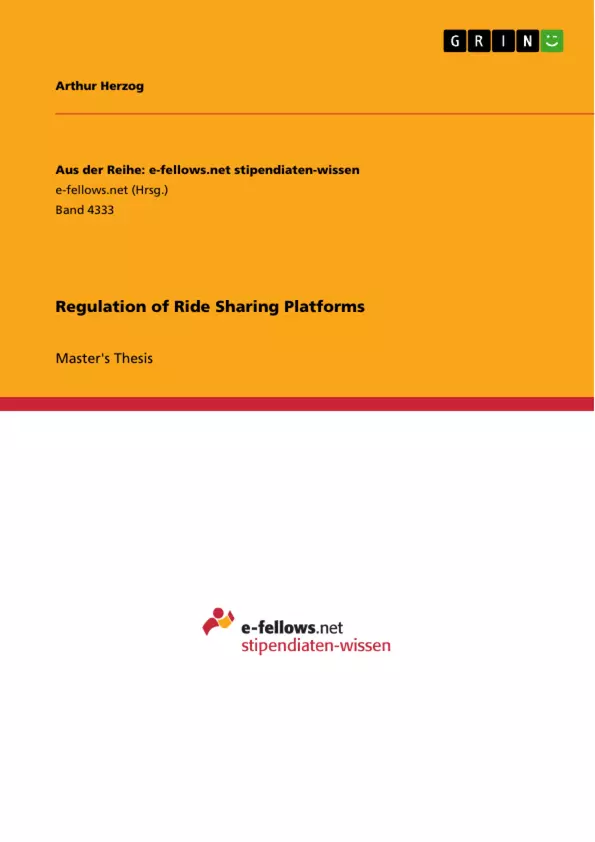How should ride-sharing platforms be regulated? The main aim of this master thesis is to provide a framework for regulators, that helps to create an appropriate regulation for ride-sharing platforms in countries like Germany where ride-sharing platforms are currently banned. To achieve that, the main differences between the conventional taxi industry and its new sharing economy entrants are outlined, and a questionnaire is used to empirically identify advantages as well as disadvantages of ride-sharing platforms. Based on these results and on the related literature, new regulatory approaches are developed.
With the rise of the internet came the rise of the sharing economy. This sharing economy is characterized by platforms which enable peers to share products and services with other peers. Hereby, these platforms are criticised to disrupt traditional industries. One famous example is the ride-sharing platform Uber which entered the taxi market and competes with conventional taxi organisations.
Uber was founded in 2009 and experienced an enormous growth since then. Uber is available in 65 countries, is used by 75 million riders and 3 million drivers, and completes 15 million rides per day. However, Uber is heavily criticised by taxi drivers because they argue that Uber bypasses local licensing and safety laws and amounts to unfair competition. There are many protests by taxi drivers against Uber all over the world. In addition, Uber is criticized for being not safe. For example, the public awareness campaign `Who´s driving you?` promotes for-hire vehicle safety and provides a list of safety incidents highlighting the risks of Uber and Lyft. Nevertheless, ride-sharing platforms like Uber offer several advantages to the public, for example user-friendly ride-hailing, cheaper transport prices, and new flexible job opportunities.
Inhaltsverzeichnis (Table of Contents)
- 1. Introduction
- 2. Basic Terminology
- 2.1. Regulation
- 2.2. Sharing Economy
- 2.3. Ride-Sharing Platforms
- 3. Related Literature
- 3.1. Economics of the Taxi Industry
- 3.2. Regulation and Deregulation of the Conventional Taxi Industry
- 3.3. Regulation of the Sharing Economy
- 4. Foundations of Regulation
- 4.1. Rationales for Regulation
- 4.2. Criteria for Optimal Regulation
- 4.3. Regulation Criticism
- 4.4. Regulation in Practice
- 5. Foundations of Ride-Sharing Platforms
- 5.1. Transaction Costs
- 5.2. Allocation of Resources
- 5.3. Information Efficiencies and Asymmetries
- 5.4. Self-Regulatory Mechanisms of Ride-Sharing Platforms
- 6. Methodology of the Empirical Study
- 6.1. Choice of Respondents
- 6.2. Questions for General Analysis
- 6.3. Questions for Regression Analysis
- 7. Results of the Empirical Study
- 7.1. General Analysis of the US Sample
- 7.2. Regression Analysis of the US Sample
- 7.3. International Comparison
- 8. Discussion and Implications for Regulators
Zielsetzung und Themenschwerpunkte (Objectives and Key Themes)
This master thesis investigates the regulation of ride-sharing platforms, focusing on the complexities and implications of this emerging sector within the digital economy. It aims to analyze the rationale for regulation, the specific challenges posed by ride-sharing platforms, and the effectiveness of existing regulatory frameworks.
- The economics and regulation of the traditional taxi industry
- The emergence and characteristics of the sharing economy, specifically ride-sharing platforms
- The foundations of regulation and its application to ride-sharing platforms
- The impact of ride-sharing platforms on resource allocation, information efficiency, and transaction costs
- An empirical study analyzing user perceptions and preferences regarding ride-sharing services
Zusammenfassung der Kapitel (Chapter Summaries)
- Chapter 1 introduces the topic of ride-sharing platforms and their regulation, outlining the scope and objectives of the thesis.
- Chapter 2 provides definitions of key terms like "regulation," "sharing economy," and "ride-sharing platforms" to establish a common understanding of the concepts discussed throughout the thesis.
- Chapter 3 explores the relevant literature on the economics of the taxi industry, regulation of the traditional taxi sector, and existing regulatory frameworks for the sharing economy.
- Chapter 4 examines the theoretical foundations of regulation, including its rationales, criteria for optimal regulation, and critiques of existing frameworks.
- Chapter 5 delves into the characteristics and operational mechanisms of ride-sharing platforms, analyzing their impact on transaction costs, resource allocation, and information flow.
- Chapter 6 outlines the methodology used in the empirical study, including the selection of respondents, survey questions, and statistical methods employed for analysis.
- Chapter 7 presents the results of the empirical study, focusing on the general analysis of the US sample, regression analysis, and international comparisons.
- Chapter 8 discusses the implications of the findings for regulators, highlighting the need for tailored and effective regulations for the ride-sharing industry.
Schlüsselwörter (Keywords)
The core topics and concepts explored in this thesis include ride-sharing platforms, sharing economy, regulation, taxi industry, transaction costs, information asymmetry, resource allocation, empirical analysis, user preferences, and regulatory frameworks. These concepts are intertwined in the exploration of the impact and future of ride-sharing services within the digital economy.
- Quote paper
- Arthur Herzog (Author), 2018, Regulation of Ride Sharing Platforms, Munich, GRIN Verlag, https://www.grin.com/document/1432037



